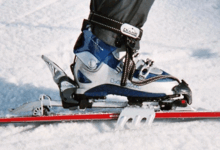Touring skis
A touring ski is a special type of ski that is used on ski tours . A touring is usually shorter, wider and softer than a typical Alpine skiing, the downhill in deep snow and swings in the wet snow easier. It is also lighter than a piste ski to allow easier ascent, but the ski loses comfort on the piste because it is not as hard and stable as alpine skis. But touring skis benefit from this again in deep snow. An important feature is the higher arched tip than on alpine skis, which is supposed to prevent undercutting in deep snow.
For the ascent on a ski tour, ski skins are strapped or glued to the running surfaces of the skis and secured against slipping at the ski tips and often also at the end of the ski. The binding of a touring ski has similar safety mechanisms as an alpine binding and allows the heel to be raised freely for ascent or fixation in the downhill position. Integrated or separately carried climbing aids allow adjustment to steeper inclination angles of the climbing track by changing the height of the heel support. Because of the limited effectiveness of Skistoppern in deep snow or on steep Harsch surfaces often come lanyard used. Climbing skins and touring bindings enable the ski tourer to push the ski forward with little resistance in a natural walking motion while walking, without sliding back down the slope with the next step. In particularly hard, so-called. Harschigem snow , come crampons as climbing aids used.

